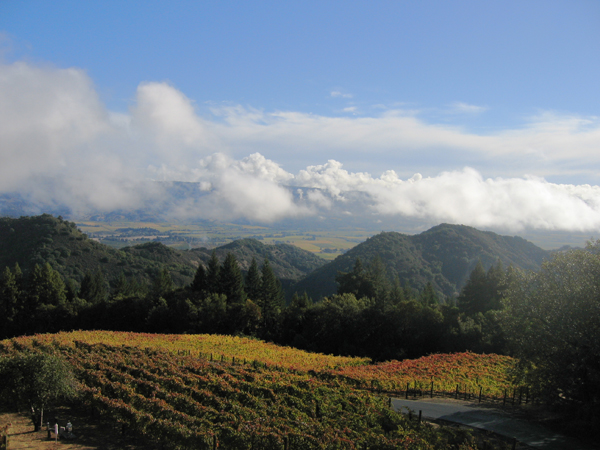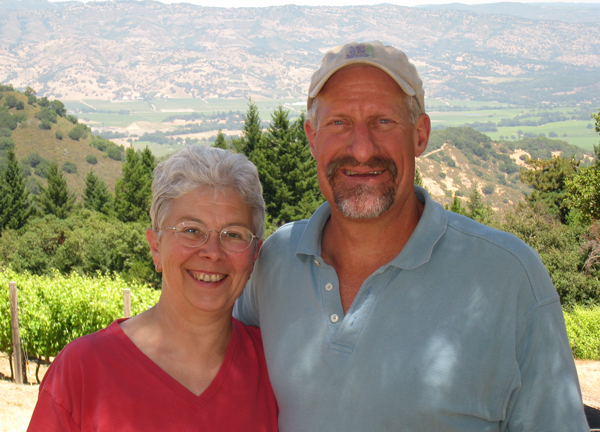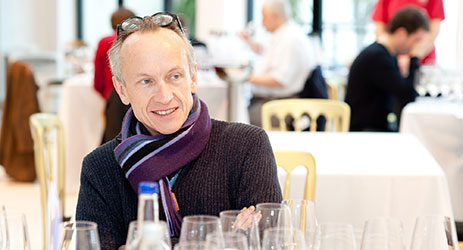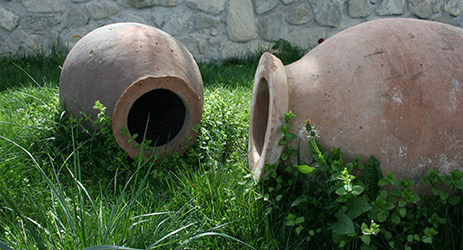Jefford on Monday
The more vineyards you visit, the more quickly you become inured to their attractions. Yes, that summer lunch under the old cedar was lovely, but the cold of winter is a different matter. Everything in the cellar is expensive, even before it has broken down. You’ll need thousands of vines; each requires personal attention four or more times a year. An invisible army of pests and diseases is out to get them all, and a rising tide of weeds to choke them; you can be sure the weather won’t help. Once you’ve got the fruit ripened, harvested, and the wine vinified and bottled, the final nightmare awaits: selling it to an indifferent world, awash with other people’s good wine. All that, plus loneliness.

Back in February, though, I visited a small vineyard so deftly self-contained, and with such an inspiring view, yet at the same time near a thriving and culturally rich metropolis, that I suddenly felt the call of vineyard ownership for, well, at least three minutes. This was Carole Meredith and Steve Lagier’s vineyard up on Mount Veeder.
Carole drove me up. And up. And up some more. When you eventually come out of the forest into the light, 400 m later, you can not only see right across the Napa valley to the Stag’s Leap crags and to Pritchard Hill, but also the upper reaches of Howell Mountain and the lonelier corners of Atlas Peak, too. Over the shoulder of the hill, the inner switchbacks of Mount Veeder unfurl like waves, wild yet intimate. The softer slopes of Carneros fall away down valley, while the sunlit bowl of San Francisco Bay beckons beyond. The fog wasn’t in when I called, but that must be spectacular, too. I imagined Steve setting out to prune in early winter, looking rather like Caspar David Friedrich’s celebrated ‘Wanderer’.

How much site research, I wondered, had they done? “Absolutely none,” replied Carole. “We bought it as a place to live in 1986. Steve was at Mondavi; I was at UC Davis. UC Davis is flat and hot but has great culture; Napa was cooler and fresher but there wasn’t much going on back then. The idea was to live in between, but in between turned out to be flat, hot and had no culture. I said ‘I’ll commute’. We looked at 70 properties. This was number 10, but we hadn’t seen enough and it had a comically awful access road and a crummy house.” Eventually, though, the site lured them back. They planted a few vines after eight years or so. “We had no plans,” remembered Carole. “But we planted a few vines after eight years, just to have something for us.” The results surprised them, so they ‘went commercial’ (in a small way: just two hectares) in 1998.
The results surprised me, too. Back in her research days in 1998, it was Carole who proved (with her doctoral student John Bowers and Montpellier’s Jean-Michel Boursiquot) that Syrah had nothing to do with ancient cities in Persia, but was a natural northern Rhône crossing of Mondeuse Blanche and Dureza, so Syrah was a doubly logical choice for them to plant up on the high-sited sandstone and shale soils of Mount Veeder. The couple have planted the black version of Mondeuse, too, as well as Malbec and Tribidrag (though they’re still calling it Zinfandel: Carole led the ‘Zinquest’ which finally sorted out its Croatian rather than Puglian roots). Obviously the USA’s greatest living ampelographical researcher and a former long-term winemaker for Robert Mondavi weren’t going to stuff up their home brew, but even so I was impressed with the freshness, purity and liveliness of the Syrah (head-turning in the 2010 but still apparent in the 2002) and, especially, by the seductive floral notes and ample, juicy tannins of the 2010 Mondeuse, which seemed more successful than many back in Savoie. ‘Mountain’ wines in Napa often end up almost as rich as their valley-floor counterparts, and there are cogent terroir reasons why this might be so. The Lagier-Meredith wines, though, were as aerial as any screaming party of swifts.
Life on the hill seems to have brought philosophical serenity, too. “Our role,” they stress on both back label and website, “is to safeguard the wine during its passage from vineyard to bottle, and to protect it from too much winemaking.” They have, they say, worked hard and lived cheap. They buy old oak, then “continue to use the barrels until they begin to fall apart.” They protect their biotope – the little lawn behind the house was dotted with orange flags which Carole had used to signal the wild lupins which had naturally established themselves there. I’d been told about Napa’s totally dry summers, but it was only when Carole showed me how the fuchsia-flowered gooseberry and the buckeye had adapted to this by simply dumping all their leaves in summer and going into dormancy, saving their growth cycle for winter, that this fact became more than merely anecdotal.
A healthy life in a beautiful place. Could I ever manage something similar? I took one look at Steve. He’s huge, strong and evidently handy. He not only knows how to prune vines and craft limpid wines but how to put fence posts in and make equipment work, how to drive trash down a vertiginous access road in winter, how not to step on poison oak, and how to capture and re-locate rattlesnakes. No, I couldn’t.

Columnist Introduction
Andrew Jefford is a columnist for both Decanter magazine and www.decanter.com, Jefford has been writing and broadcasting about wine (as well as food, whisky, travel and perfume) since the 1980s, winning many awards – the latest for his work as a columnist. After 15 months as a senior research fellow at Adelaide University between 2009 and 2010, Andrew is currently writing a book on Australia’s wine landscape and terroirs. He lives in the Languedoc, on the frontier between the Grès de Montpellier and Pic St Loup zones.
Click here to read all articles by Andrew Jefford>>
- Follow us on Weibo @Decanter醇鉴 -
-
All rights reserved by Future plc. No part of this publication may be reproduced, distributed or transmitted in any form or by any means without the prior written permission of Decanter.
Only Official Media Partners (see About us) of DecanterChina.com may republish part of the content from the site without prior permission under strict Terms & Conditions. Contact china@decanter.com to learn about how to become an Official Media Partner of DecanterChina.com.



Comments
Submit